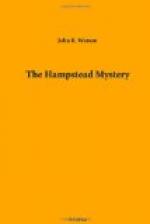“Now, gentlemen, you have all seen the plan which this tainted witness declares was drawn by him because Birchill terrorised him and stood over him while he drew it. Is there anything in that plan to suggest that it was drawn by a man in a state of nervous terror? Why, the lines are as firmly drawn as if they had been made by an architect working at his leisure in his office. Was this plan drawn by a man in a state of nervous terror with his tormentor standing threateningly over him, or was it drawn up by a man working at leisure, free not only from terror but from interruption? The answer to that question is supplied in the evidence given by three witnesses as to the paper used. Hill says the plan was drawn at the flat. Two other witnesses swore that it was paper supplied exclusively for Government Departments, and another witness swore that he had taken such paper to Riversbrook for the use of Sir Horace Fewbanks, who, like every one of His Majesty’s judges, found it necessary to do some of his judicial work at home. What is the inevitable inference? I ask you if you can have any doubt, after looking at that plan and after hearing the evidence given to-day about the paper, that the proposal to rob Riversbrook was Hill’s own proposal, that Hill drew a plan of the house on paper he abstracted from his master’s desk—paper which this confidential servant was apparently in the habit of using for private purposes—and that he gave it to Birchill when he asked Birchill to join him in the crime?
“When one of the main features of Hill’s story is proved to be false, how can you believe any of the rest? In the light in which we now see him, with his cunning exposed, what significance is to be attached to his statement that Birchill in his presence threatened to shoot Sir Horace Fewbanks if the master of Riversbrook interfered with him? Such a threat was not made, but why should Hill say it was made? For the same reason that he lied about the plan—to save his own skin. I submit to you, gentlemen, that when Hill went to see Birchill at the Westminster flat on the night arranged for the burglary Sir Horace Fewbanks was dead—murdered—and that Hill knew he was murdered. His own story is that he tried to persuade Birchill to abandon the proposed burglary, but, according to the witness Fanning, he did all in his power to induce Birchill to carry out the original plan when he saw that Birchill was disposed to postpone the burglary in view of the return of the master of Riversbrook. Why did he want Birchill to carry out the burglary? Because he knew that his master’s murdered body was lying in the house, and he wanted to be in the position to produce evidence against Birchill as the murderer if he found himself in a tight corner as the result of the subsequent investigations of the police. Remember that the body of the victim was fully dressed when it was discovered by the police, and that none of the electric lights were burning. Does not that prove conclusively that the murder was not committed by Birchill, that Sir Horace Fewbanks was dead when Birchill broke into the house?




